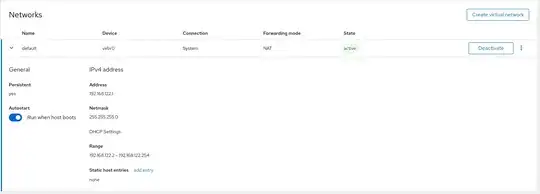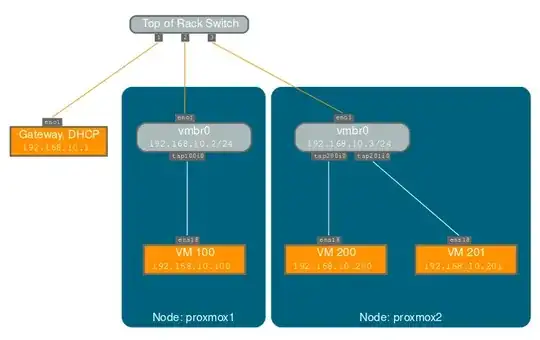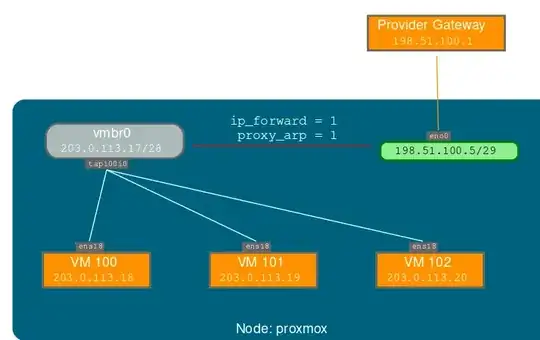Background Problems
I have a Dedicated Server (Ubuntu 22.04.1 LTS) with five Public IPs as below:
- xxx.xxx.51.20 (Main Ip)
- xxx.xxx.198.104
- xxx.xxx.198.105
- xxx.xxx.198.106
- xxx.xxx.198.107
I want to hosts several KVM VM inside this server and assign some of the VM a public IP from the host, or simply imagine creating several Virtual Private Servers (VPS) with each having Public IP.
If I am not wrong, I need to create a bridge network. I already did and have br0 bridges with all public IPs assigned there.
Currently, here is the Hosts network configuration:
cat /etc/netplan/50-cloud-init.yaml:
network:
version: 2
renderer: networkd
ethernets:
eno1:
dhcp4: false
dhcp6: false
match:
macaddress: xx:xx:xx:2a:19:d0
set-name: eno1
bridges:
br0:
interfaces: [eno1]
addresses:
- xxx.xxx.51.20/32
- xxx.xxx.198.104/32
- xxx.xxx.198.105/32
- xxx.xxx.198.106/32
- xxx.xxx.198.107/32
routes:
- to: default
via: xxx.xxx.51.1
metric: 100
on-link: true
mtu: 1500
nameservers:
addresses: [8.8.8.8]
parameters:
stp: true
forward-delay: 4
dhcp4: no
dhcp6: no
With this configuration, all of the IP is pointing to the hosts, and can reach the hosts successfully.
Here is the hosts ip a record:
$ ip a
1: lo: <LOOPBACK,UP,LOWER_UP> mtu 65536 qdisc noqueue state UNKNOWN group default qlen 1000
link/loopback 00:00:00:00:00:00 brd 00:00:00:00:00:00
inet 127.0.0.1/8 scope host lo
valid_lft forever preferred_lft forever
inet6 ::1/128 scope host
valid_lft forever preferred_lft forever
2: eno1: <BROADCAST,MULTICAST,UP,LOWER_UP> mtu 1500 qdisc mq master br0 state UP group default qlen 1000
link/ether xx:xx:xx:2a:19:d0 brd ff:ff:ff:ff:ff:ff
altname enp2s0
3: eno2: <BROADCAST,MULTICAST> mtu 1500 qdisc noop state DOWN group default qlen 1000
link/ether xx:xx:xx:2a:19:d1 brd ff:ff:ff:ff:ff:ff
altname enp3s0
4: br0: <BROADCAST,MULTICAST,UP,LOWER_UP> mtu 1500 qdisc noqueue state UP group default qlen 1000
link/ether xx:xx:xx:59:36:78 brd ff:ff:ff:ff:ff:ff
inet xxx.xxx.51.20/32 scope global br0
valid_lft forever preferred_lft forever
inet xxx.xxx.198.104/32 scope global br0
valid_lft forever preferred_lft forever
inet xxx.xxx.198.105/32 scope global br0
valid_lft forever preferred_lft forever
inet xxx.xxx.198.106/32 scope global br0
valid_lft forever preferred_lft forever
inet xxx.xxx.198.107/32 scope global br0
valid_lft forever preferred_lft forever
inet6 xxxx::xxxx:xxxx:xxxx:3678/64 scope link
valid_lft forever preferred_lft forever
5: virbr0: <BROADCAST,MULTICAST,UP,LOWER_UP> mtu 1500 qdisc noqueue state UP group default qlen 1000
link/ether xx:xx:xx:e2:3e:ea brd ff:ff:ff:ff:ff:ff
inet 192.168.122.1/24 brd 192.168.122.255 scope global virbr0
valid_lft forever preferred_lft forever
6: docker0: <NO-CARRIER,BROADCAST,MULTICAST,UP> mtu 1500 qdisc noqueue state DOWN group default
link/ether xx:xx:xx:ff:4c:03 brd ff:ff:ff:ff:ff:ff
inet 172.17.0.1/16 brd 172.17.255.255 scope global docker0
valid_lft forever preferred_lft forever
9: vnet2: <BROADCAST,MULTICAST,UP,LOWER_UP> mtu 1500 qdisc noqueue master br0 state UNKNOWN group default qlen 1000
link/ether xx:xx:xx:6b:01:05 brd ff:ff:ff:ff:ff:ff
inet6 xxxx::xxxx:ff:fe6b:105/64 scope link
valid_lft forever preferred_lft forever
10: vnet3: <BROADCAST,MULTICAST,UP,LOWER_UP> mtu 1500 qdisc noqueue master virbr0 state UNKNOWN group default qlen 1000
link/ether xx:xx:xx:16:07:56 brd ff:ff:ff:ff:ff:ff
inet6 xxxx::xxxx:ff:fe16:756/64 scope link
valid_lft forever preferred_lft forever
Then I create a KVM VM with two network attached (one for the br0 and the other is NAT based bridge)
And from the VM, I configure the netplan to be like this:
cat /etc/netplan/00-installer-config.yaml/:
network:
version: 2
ethernets:
enp1s0:
addresses:
- xxx.xxx.198.104/32
routes:
- to: default
via: xxx.xxx.198.1
metric: 100
on-link: true
nameservers:
addresses:
- 1.1.1.1
- 1.1.0.0
- 8.8.8.8
- 8.8.4.4
search: []
enp7s0:
dhcp4: true
dhcp6: true
match:
macaddress: xx:xx:xx:16:07:56
Here the VM use enp1s0 for the static Public IP (xxx.xxx.198.104) and enp7s0 for the NAT from hosts (192.168.122.xxx).
From VM ip a command, it shown that the VM get correct IP.
The problem:
- When I try to ssh directly from my laptop to the VM public IP (xxx.xxx.198.104), it seems that I still connected to the Host, not to the VM.
- From the VM, if I disconnect the NAT network (enp7s0), and only use the (enp1s0) network with public IP, it seems the VM cannot connect to the internet.
Is there something I missed?
Update 1
I contacted the DC provider, they have documentation to add Public IP to VM here https://docs.ovh.com/gb/en/dedicated/network-bridging/ but only applicable if I use Proxmox as the host. I need to create a bridge network with the specified Mac Address attached to that bridge, then from VM we need to apply the Public IP.
How to do that on Ubuntu?
Update 2
I managed to create the bridge network with my Public IP on the hosts side with the following command:
sudo ip link add name test-bridge link eth0 type macvlan
sudo ip link set dev test-bridge address MAC_ADDRESS
sudo ip link set test-bridge up
sudo ip addr add ADDITIONAL_IP/32 dev test-bridge
And I repeated it 4 times to add all my public IP to host.
Now my hosts configuration is below:
cat /etc/netplan/50-cloud-init.yaml
network:
version: 2
ethernets:
eno1:
dhcp4: true
match:
macaddress: xx:xx:xx:2a:19:d0
set-name: eno1
And ip a:
1: lo: <LOOPBACK,UP,LOWER_UP> mtu 65536 qdisc noqueue state UNKNOWN group default qlen 1000
link/loopback 00:00:00:00:00:00 brd 00:00:00:00:00:00
inet 127.0.0.1/8 scope host lo
valid_lft forever preferred_lft forever
inet6 ::1/128 scope host
valid_lft forever preferred_lft forever
2: eno1: <BROADCAST,MULTICAST,UP,LOWER_UP> mtu 1500 qdisc mq state UP group default qlen 1000
link/ether xx:xx:xx:2a:19:d0 brd ff:ff:ff:ff:ff:ff
altname enp2s0
inet xxx.xxx.51.20/24 metric 100 brd xx.xx.51.255 scope global dynamic eno1
valid_lft 84658sec preferred_lft 84658sec
inet6 xxxx::xxxx:xxxx:fe2a:19d0/64 scope link
valid_lft forever preferred_lft forever
3: eno2: <BROADCAST,MULTICAST> mtu 1500 qdisc noop state DOWN group default qlen 1000
link/ether xx:xx:xx:2a:19:d1 brd ff:ff:ff:ff:ff:ff
altname enp3s0
4: virbr0: <NO-CARRIER,BROADCAST,MULTICAST,UP> mtu 1500 qdisc noqueue state DOWN group default qlen 1000
link/ether xx:xx:xx:e2:3e:ea brd ff:ff:ff:ff:ff:ff
inet 192.168.122.1/24 brd 192.168.122.255 scope global virbr0
valid_lft forever preferred_lft forever
5: docker0: <NO-CARRIER,BROADCAST,MULTICAST,UP> mtu 1500 qdisc noqueue state DOWN group default
link/ether xx:xx:xx:e1:2b:ce brd ff:ff:ff:ff:ff:ff
inet 172.17.0.1/16 brd 172.17.255.255 scope global docker0
valid_lft forever preferred_lft forever
6: vmbr1@eno1: <BROADCAST,MULTICAST,UP,LOWER_UP> mtu 1500 qdisc noqueue state UP group default qlen 1000
link/ether xx:xx:xx:79:26:12 brd ff:ff:ff:ff:ff:ff
inet xxx.xxx.198.104/32 scope global vmbr1
valid_lft forever preferred_lft forever
inet6 xxxx::xxxx:xxxx:2612/64 scope link
valid_lft forever preferred_lft forever
7: vmbr2@eno1: <BROADCAST,MULTICAST,UP,LOWER_UP> mtu 1500 qdisc noqueue state UP group default qlen 1000
link/ether xx:xx:xx:f3:e2:85 brd ff:ff:ff:ff:ff:ff
inet xxx.xxx.198.105/32 scope global vmbr2
valid_lft forever preferred_lft forever
inet6 xxxx::xxxx:xxxx:e285/64 scope link
valid_lft forever preferred_lft forever
8: vmbr3@eno1: <BROADCAST,MULTICAST,UP,LOWER_UP> mtu 1500 qdisc noqueue state UP group default qlen 1000
link/ether xx:xx:xx:48:a8:c9 brd ff:ff:ff:ff:ff:ff
inet xxx.xxx.198.106/32 scope global vmbr3
valid_lft forever preferred_lft forever
inet6 xxxx::xxxx:xxxx:a8c9/64 scope link
valid_lft forever preferred_lft forever
9: vmbr4@eno1: <BROADCAST,MULTICAST,UP,LOWER_UP> mtu 1500 qdisc noqueue state UP group default qlen 1000
link/ether xx:xx:xx:eb:29:a1 brd ff:ff:ff:ff:ff:ff
inet xxx.xxx.198.107/32 scope global vmbr4
valid_lft forever preferred_lft forever
inet6 xxxx::xxxx:xxxx:29a1/64 scope link
valid_lft forever preferred_lft forever
I tested to ping all the IP Addressed from my laptop and it works.
On the VM side, I edit the networking to be like this:
sudo virsh edit vm_name and look for network interface:
<interface type='network'>
<mac address='xx:xx:xx:16:07:56'/>
<source network='default'/>
<model type='virtio'/>
<address type='pci' domain='0x0000' bus='0x07' slot='0x00' function='0x0'/>
</interface>
<interface type='bridge'>
<mac address='xx:xx:xx:79:26:12'/>
<source bridge='vmbr1'/>
<model type='virtio'/>
<address type='pci' domain='0x0000' bus='0x01' slot='0x00' function='0x0'/>
</interface>
The problem now, I cannot start the VM:
$ sudo virsh start lab
error: Failed to start domain 'vm_name'
error: Unable to add bridge vmbr1 port vnet8: Operation not supported
Is there something missed again?
Update 3
I found out that using sudo ip link add ... command only works temporary, it will be lost after server reboot.
Please guide me to make the proper Host configuration and VM side configuration.
Thanks
Update 4
I read Proxmox configuration reference here (https://pve.proxmox.com/wiki/Network_Configuration) and I tried to implement the Routed configuration on the Hosts.
Thus, I installed ifupdown packages, and create configuration below:
auto lo
iface lo inet loopback
auto eno0
iface eno0 inet static
address xxx.xxx.51.20/24
gateway xxx.xxx.51.254
post-up echo 1 > /proc/sys/net/ipv4/ip_forward
post-up echo 1 > /proc/sys/net/ipv4/conf/eno0/proxy_arp
auto vmbr0
iface vmbr0 inet static
address xxx.xxx.198.104/24
bridge-ports none
bridge-stp off
bridge-fd 0
auto vmbr1
iface vmbr1 inet static
address xxx.xxx.198.105/24
bridge-ports none
bridge-stp off
bridge-fd 0
auto vmbr2
iface vmbr2 inet static
address xxx.xxx.198.106/24
bridge-ports none
bridge-stp off
bridge-fd 0
auto vmbr3
iface vmbr3 inet static
address xxx.xxx.198.107/24
bridge-ports none
bridge-stp off
bridge-fd 0
I also disable systemd networking as suggested here (https://askubuntu.com/a/1052023) with the following command:
sudo systemctl unmask networking
sudo systemctl enable networking
sudo systemctl restart networking
sudo journalctl -xeu networking.service
sudo systemctl stop systemd-networkd.socket systemd-networkd networkd-dispatcher systemd-networkd-wait-online
sudo systemctl disable systemd-networkd.socket systemd-networkd networkd-dispatcher systemd-networkd-wait-online
sudo systemctl mask systemd-networkd.socket systemd-networkd networkd-dispatcher systemd-networkd-wait-online
With this configuration, from the VM perspective, it can read that the VM get 2 IP (one private and one public).
However, I got another problem:
sudo systemctl status networkingalways resulted in failed. With log like this:
$ sudo systemctl status networking.service
× networking.service - Raise network interfaces
Loaded: loaded (/lib/systemd/system/networking.service; enabled; vendor preset: enabled)
Active: failed (Result: exit-code) since Tue 2022-12-13 18:51:27 UTC; 7min ago
Docs: man:interfaces(5)
Main PID: 1000 (code=exited, status=1/FAILURE)
CPU: 631ms
Dec 13 18:51:25 hostname ifup[1054]: /etc/network/if-up.d/resolved: 12: mystatedir: not found
Dec 13 18:51:25 hostname ifup[1066]: RTNETLINK answers: File exists
Dec 13 18:51:25 hostname ifup[1000]: ifup: failed to bring up eno1
Dec 13 18:51:26 hostname ifup[1132]: /etc/network/if-up.d/resolved: 12: mystatedir: not found
Dec 13 18:51:26 hostname ifup[1215]: /etc/network/if-up.d/resolved: 12: mystatedir: not found
Dec 13 18:51:27 hostname ifup[1298]: /etc/network/if-up.d/resolved: 12: mystatedir: not found
Dec 13 18:51:27 hostname ifup[1381]: /etc/network/if-up.d/resolved: 12: mystatedir: not found
Dec 13 18:51:27 hostname systemd[1]: networking.service: Main process exited, code=exited, status=1/FAILURE
Dec 13 18:51:27 hostname systemd[1]: networking.service: Failed with result 'exit-code'.
Dec 13 18:51:27 hostname systemd[1]: Failed to start Raise network interfaces.
and journalctl:
$ sudo journalctl -xeu networking.service
░░ The process' exit code is 'exited' and its exit status is 1.
Dec 13 18:49:08 hostname systemd[1]: networking.service: Failed with result 'exit-code'.
░░ Subject: Unit failed
░░ Defined-By: systemd
░░ Support: http://www.ubuntu.com/support
░░
░░ The unit networking.service has entered the 'failed' state with result 'exit-code'.
Dec 13 18:49:08 hostname systemd[1]: Failed to start Raise network interfaces.
░░ Subject: A start job for unit networking.service has failed
░░ Defined-By: systemd
░░ Support: http://www.ubuntu.com/support
░░
░░ A start job for unit networking.service has finished with a failure.
░░
░░ The job identifier is 3407 and the job result is failed.
-- Boot 50161a44ec43452692ce64fca20cce9d --
Dec 13 18:51:25 hostname systemd[1]: Starting Raise network interfaces...
░░ Subject: A start job for unit networking.service has begun execution
░░ Defined-By: systemd
░░ Support: http://www.ubuntu.com/support
░░
░░ A start job for unit networking.service has begun execution.
░░
░░ The job identifier is 49.
Dec 13 18:51:25 hostname ifup[1054]: /etc/network/if-up.d/resolved: 12: mystatedir: not found
Dec 13 18:51:25 hostname ifup[1066]: RTNETLINK answers: File exists
Dec 13 18:51:25 hostname ifup[1000]: ifup: failed to bring up eno1
Dec 13 18:51:26 hostname ifup[1132]: /etc/network/if-up.d/resolved: 12: mystatedir: not found
Dec 13 18:51:26 hostname ifup[1215]: /etc/network/if-up.d/resolved: 12: mystatedir: not found
Dec 13 18:51:27 hostname ifup[1298]: /etc/network/if-up.d/resolved: 12: mystatedir: not found
Dec 13 18:51:27 hostname ifup[1381]: /etc/network/if-up.d/resolved: 12: mystatedir: not found
Dec 13 18:51:27 hostname systemd[1]: networking.service: Main process exited, code=exited, status=1/FAILURE
░░ Subject: Unit process exited
░░ Defined-By: systemd
░░ Support: http://www.ubuntu.com/support
░░
░░ An ExecStart= process belonging to unit networking.service has exited.
░░
░░ The process' exit code is 'exited' and its exit status is 1.
Dec 13 18:51:27 hostname systemd[1]: networking.service: Failed with result 'exit-code'.
░░ Subject: Unit failed
░░ Defined-By: systemd
░░ Support: http://www.ubuntu.com/support
░░
░░ The unit networking.service has entered the 'failed' state with result 'exit-code'.
Dec 13 18:51:27 hostname systemd[1]: Failed to start Raise network interfaces.
░░ Subject: A start job for unit networking.service has failed
░░ Defined-By: systemd
░░ Support: http://www.ubuntu.com/support
░░
░░ A start job for unit networking.service has finished with a failure.
░░
░░ The job identifier is 49 and the job result is failed.
ip a results on hosts:
$ ip a
1: lo: <LOOPBACK,UP,LOWER_UP> mtu 65536 qdisc noqueue state UNKNOWN group default qlen 1000
link/loopback 00:00:00:00:00:00 brd 00:00:00:00:00:00
inet 127.0.0.1/8 scope host lo
valid_lft forever preferred_lft forever
inet6 ::1/128 scope host
valid_lft forever preferred_lft forever
2: eno1: <BROADCAST,MULTICAST,UP,LOWER_UP> mtu 1500 qdisc mq state UP group default qlen 1000
link/ether xx:xx:xx:2a:19:d0 brd ff:ff:ff:ff:ff:ff
altname enp2s0
inet xxx.xxx.51.20/24 brd xx.xxx.51.255 scope global eno1
valid_lft forever preferred_lft forever
inet6 xxxx::xxxx:xxxx:xxxx:19d0/64 scope link
valid_lft forever preferred_lft forever
3: eno2: <BROADCAST,MULTICAST> mtu 1500 qdisc noop state DOWN group default qlen 1000
link/ether xx:xx:xx:2a:19:d1 brd ff:ff:ff:ff:ff:ff
altname enp3s0
4: vmbr0: <NO-CARRIER,BROADCAST,MULTICAST,UP> mtu 1500 qdisc noqueue state DOWN group default qlen 1000
link/ether xx:xx:xx:b3:96:06 brd ff:ff:ff:ff:ff:ff
inet xxx.xxx.198.104/24 brd xxx.xxx.198.255 scope global vmbr0
valid_lft forever preferred_lft forever
5: vmbr1: <NO-CARRIER,BROADCAST,MULTICAST,UP> mtu 1500 qdisc noqueue state DOWN group default qlen 1000
link/ether xx:xx:xx:a8:1a:49 brd ff:ff:ff:ff:ff:ff
inet xxx.xxx.198.105/24 brd xxx.xxx.198.255 scope global vmbr1
valid_lft forever preferred_lft forever
6: vmbr2: <NO-CARRIER,BROADCAST,MULTICAST,UP> mtu 1500 qdisc noqueue state DOWN group default qlen 1000
link/ether xx:xx:xx:d8:82:25 brd ff:ff:ff:ff:ff:ff
inet xxx.xxx.198.106/24 brd xxx.xxx.198.255 scope global vmbr2
valid_lft forever preferred_lft forever
7: vmbr3: <NO-CARRIER,BROADCAST,MULTICAST,UP> mtu 1500 qdisc noqueue state DOWN group default qlen 1000
link/ether xx:xx:xx:4d:aa:31 brd ff:ff:ff:ff:ff:ff
inet xxx.xxx.198.107/24 brd xxx.xxx.198.255 scope global vmbr3
valid_lft forever preferred_lft forever
8: virbr0: <NO-CARRIER,BROADCAST,MULTICAST,UP> mtu 1500 qdisc noqueue state DOWN group default qlen 1000
link/ether 52:54:00:e2:3e:ea brd ff:ff:ff:ff:ff:ff
inet 192.168.122.1/24 brd 192.168.122.255 scope global virbr0
valid_lft forever preferred_lft forever
9: docker0: <NO-CARRIER,BROADCAST,MULTICAST,UP> mtu 1500 qdisc noqueue state DOWN group default
link/ether 02:42:8c:f2:63:f5 brd ff:ff:ff:ff:ff:ff
inet 172.17.0.1/16 brd 172.17.255.255 scope global docker0
valid_lft forever preferred_lft forever
Although the VM can read 2 interfaces (private and public IP), I can't reach the VM public IP from my laptop, it seems on the hosts side, the connection is not forwarded to the VM.
If all above problem is caused by networking service that failing to start, is there any fix for this?
If, netplan / systemd networking is the proper way to configure networking on Ubuntu 22.04, how is the correct netplan configuration for bridging like this case?
$ cat /etc/network/interfaces
auto lo
iface lo inet loopback
auto eno0
iface eno0 inet static
address xxx.xxx.51.20/24
gateway xxx.xxx.51.254
post-up echo 1 > /proc/sys/net/ipv4/ip_forward
post-up echo 1 > /proc/sys/net/ipv4/conf/eno0/proxy_arp
auto vmbr0
iface vmbr0 inet static
address xxx.xxx.198.104/24
bridge-ports none
bridge-stp off
bridge-fd 0
auto vmbr1
iface vmbr1 inet static
address xxx.xxx.198.105/24
bridge-ports none
bridge-stp off
bridge-fd 0
auto vmbr2
iface vmbr2 inet static
address xxx.xxx.198.106/24
bridge-ports none
bridge-stp off
bridge-fd 0
auto vmbr3
iface vmbr3 inet static
address xxx.xxx.198.107/24
bridge-ports none
bridge-stp off
bridge-fd 0


